LEXUS RX350 2011 Owners Manual
Manufacturer: LEXUS, Model Year: 2011, Model line: RX350, Model: LEXUS RX350 2011Pages: 821, PDF Size: 13.27 MB
Page 211 of 821
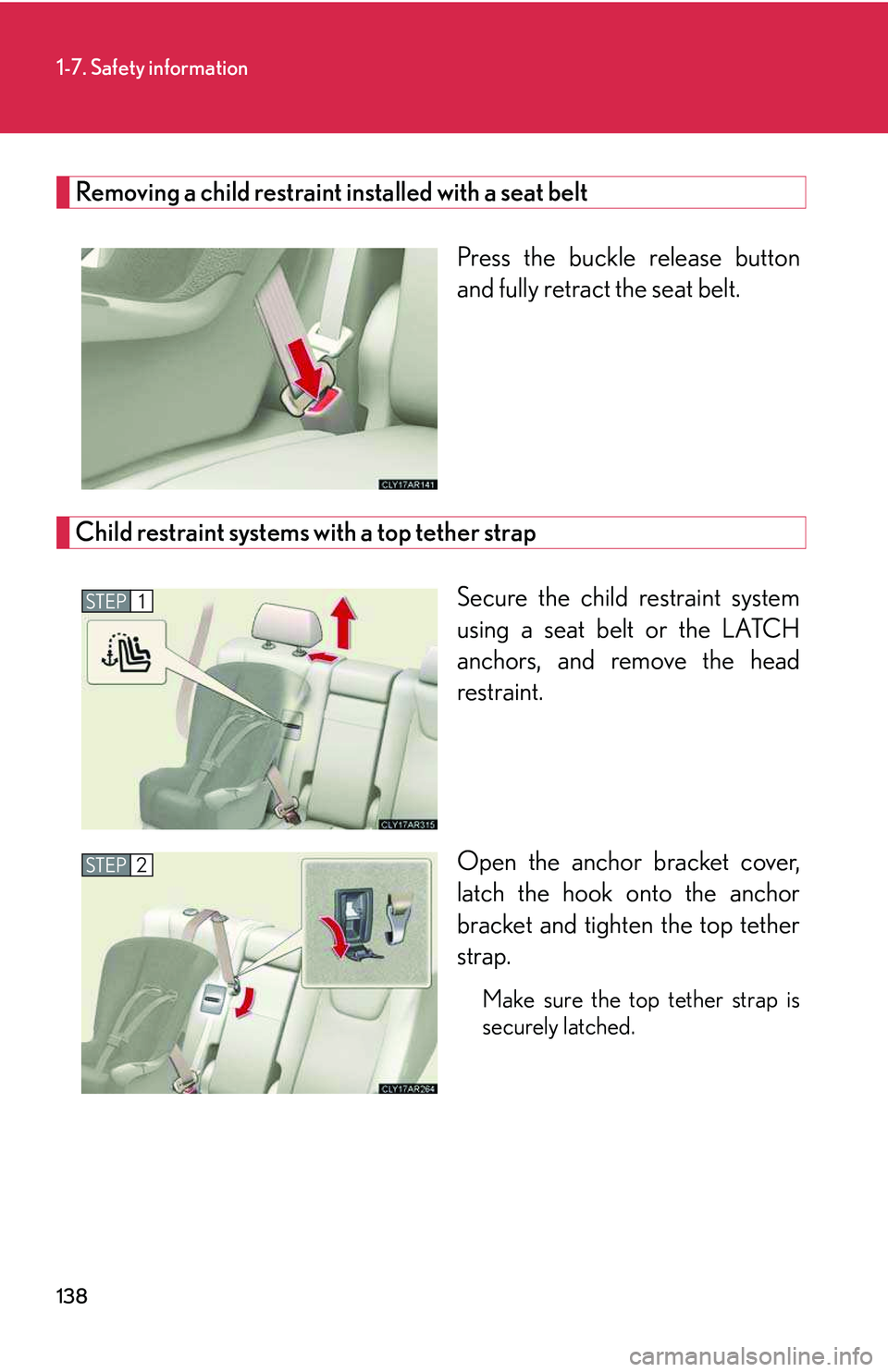
138
1-7. Safety information
Removing a child restraint installed with a seat belt
Press the buckle release button
and fully retract the seat belt.
Child restraint systems with a top tether strap
Secure the child restraint system
using a seat belt or the LATCH
anchors, and remove the head
restraint.
Open the anchor bracket cover,
latch the hook onto the anchor
bracket and tighten the top tether
strap.
Make sure the top tether strap is
securely latched.
STEP1
STEP2
Page 212 of 821
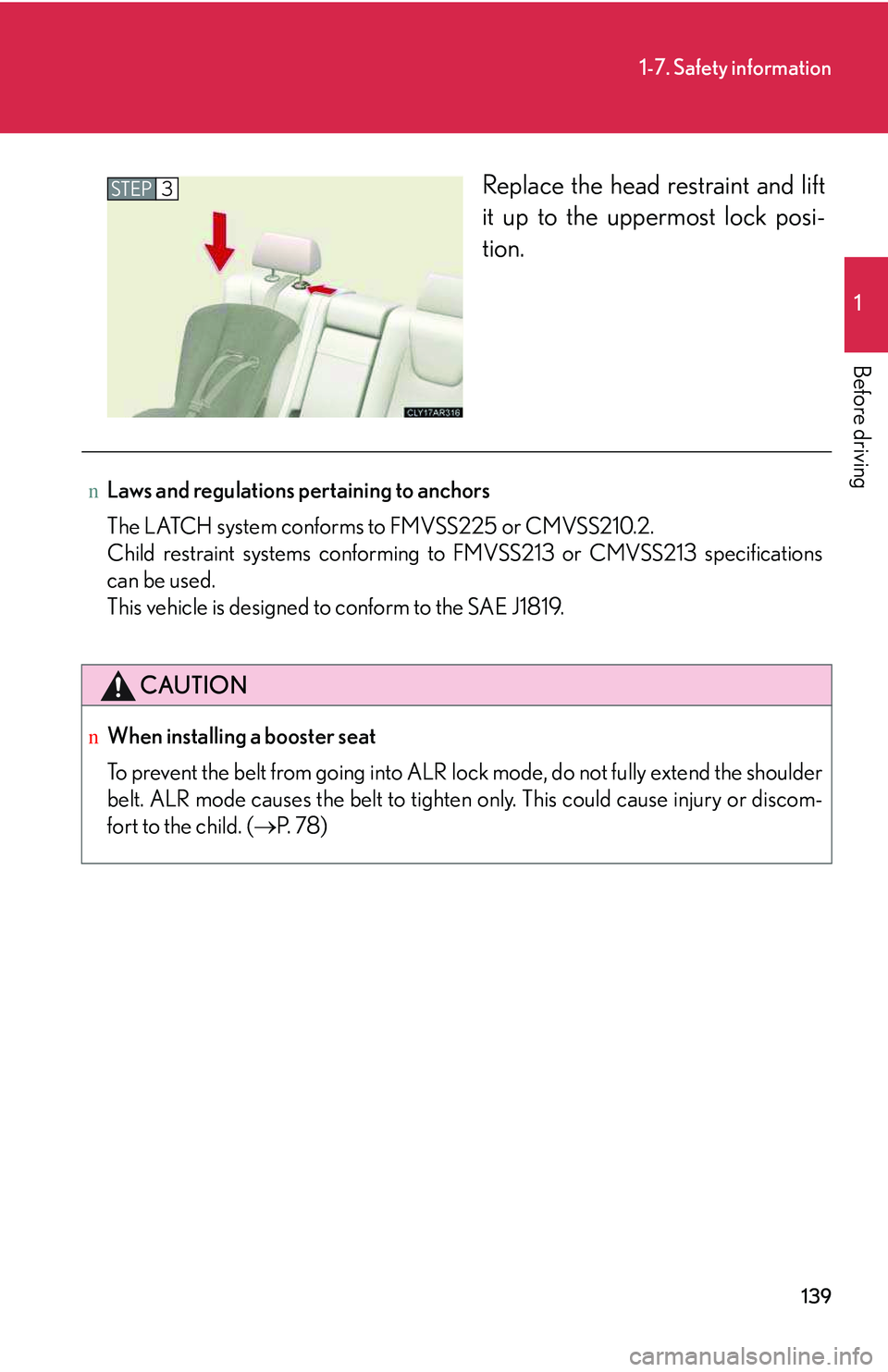
139
1-7. Safety information
1
Before driving
Replace the head restraint and lift
it up to the uppermost lock posi-
tion.
STEP3
nLaws and regulations pertaining to anchors
The LATCH system conforms to FMVSS225 or CMVSS210.2.
Child restraint systems conforming to FMVSS213 or CMVSS213 specifications
can be used.
This vehicle is designed to conform to the SAE J1819.
CAUTION
nWhen installing a booster seat
To prevent the belt from going into ALR lock mode, do not fully extend the shoulder
belt. ALR mode causes the belt to tighten only. This could cause injury or discom-
fort to the child. (�→P. 7 8 )
Page 213 of 821
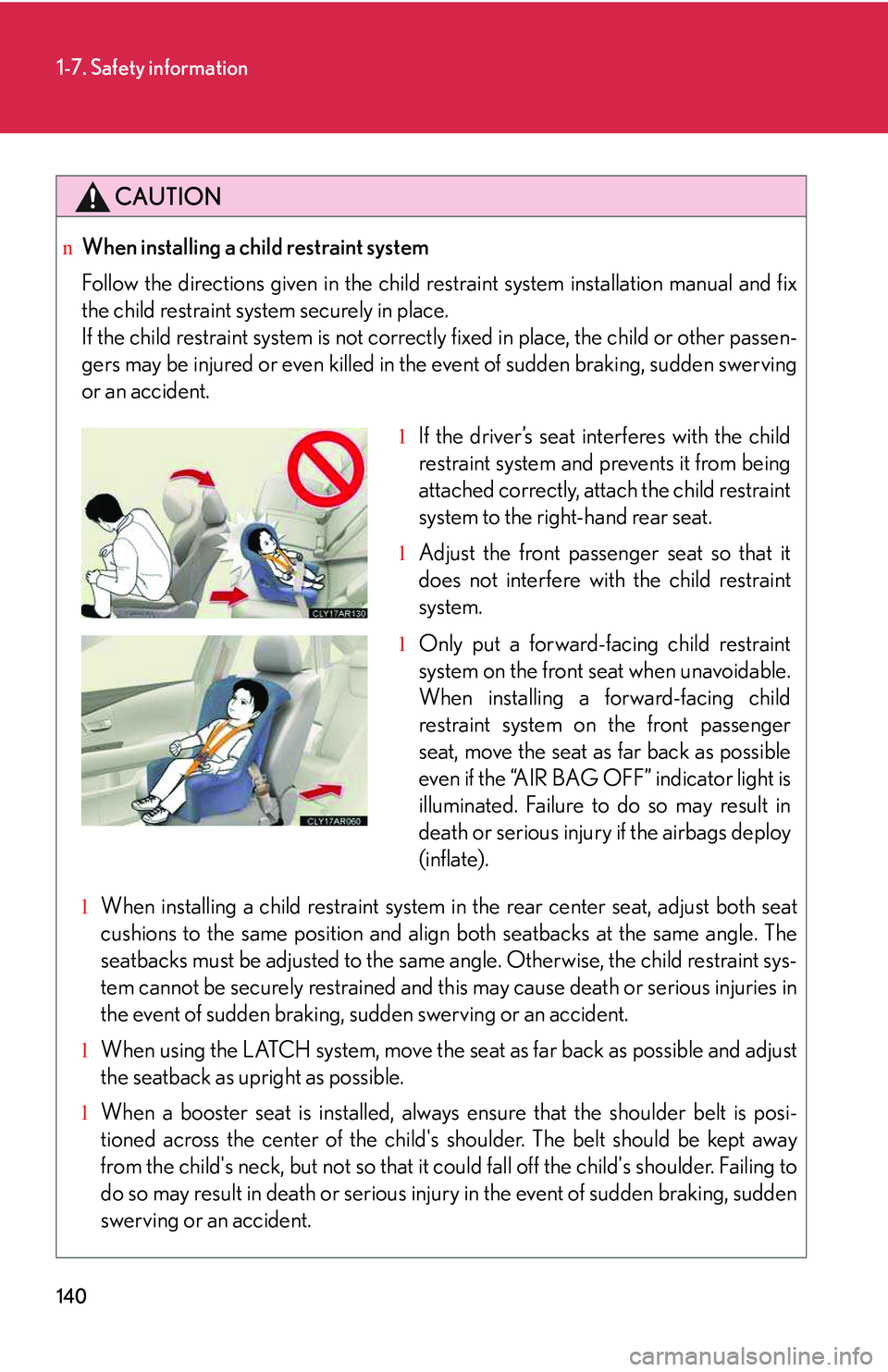
140
1-7. Safety information
CAUTION
nWhen installing a child restraint system
Follow the directions given in the child restraint system installation manual and fix
the child restraint system securely in place.
If the child restraint system is not correctly fixed in place, the child or other passen-
gers may be injured or even killed in the event of sudden braking, sudden swerving
or an accident.
lWhen installing a child restraint system in the rear center seat, adjust both seat
cushions to the same position and align both seatbacks at the same angle. The
seatbacks must be adjusted to the same angle. Otherwise, the child restraint sys-
tem cannot be securely restrained and this may cause death or serious injuries in
the event of sudden braking, sudden swerving or an accident.
lWhen using the LATCH system, move the seat as far back as possible and adjust
the seatback as upright as possible.
lWhen a booster seat is installed, always ensure that the shoulder belt is posi-
tioned across the center of the child's shoulder. The belt should be kept away
from the child's neck, but not so that it could fall off the child's shoulder. Failing to
do so may result in death or serious injury in the event of sudden braking, sudden
swerving or an accident.
lIf the driver’s seat interferes with the child
restraint system and prevents it from being
attached correctly, attach the child restraint
system to the right-hand rear seat.
lAdjust the front passenger seat so that it
does not interfere with the child restraint
system.
lOnly put a forward-facing child restraint
system on the front seat when unavoidable.
When installing a forward-facing child
restraint system on the front passenger
seat, move the seat as far back as possible
even if the “AIR BAG OFF” indicator light is
illuminated. Failure to do so may result in
death or serious injury if the airbags deploy
(inflate).
Page 214 of 821
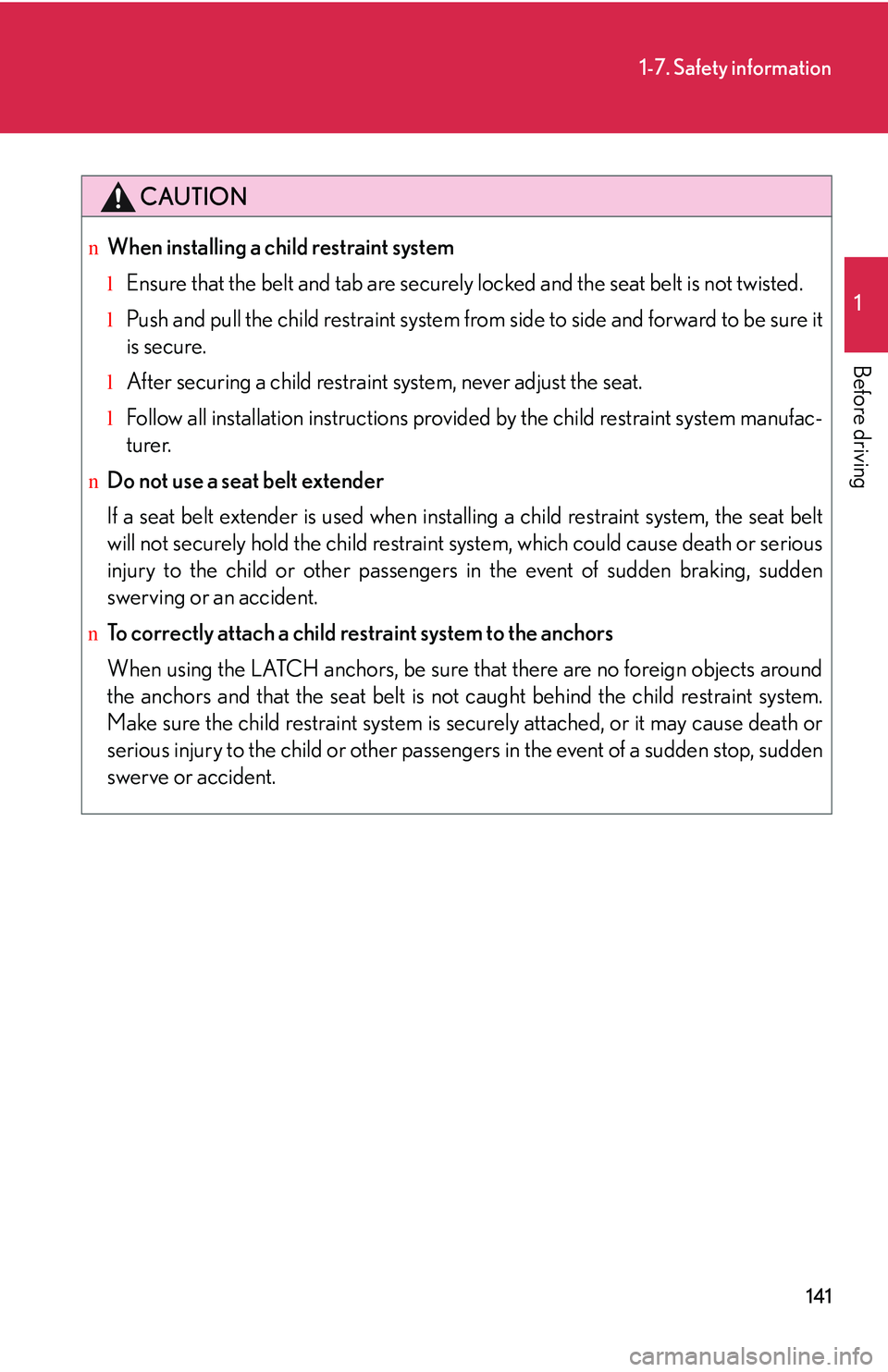
141
1-7. Safety information
1
Before driving
CAUTION
nWhen installing a child restraint system
lEnsure that the belt and tab are securely locked and the seat belt is not twisted.
lPush and pull the child restraint system from side to side and forward to be sure it
is secure.
lAfter securing a child restraint system, never adjust the seat.
lFollow all installation instructions provided by the child restraint system manufac-
turer.
nDo not use a seat belt extender
If a seat belt extender is used when installing a child restraint system, the seat belt
will not securely hold the child restraint system, which could cause death or serious
injury to the child or other passengers in the event of sudden braking, sudden
swerving or an accident.
nTo correctly attach a child restraint system to the anchors
When using the LATCH anchors, be sure that there are no foreign objects around
the anchors and that the seat belt is not caught behind the child restraint system.
Make sure the child restraint system is securely attached, or it may cause death or
serious injury to the child or other passengers in the event of a sudden stop, sudden
swerve or accident.
Page 215 of 821

142
1-7. Safety information
Page 216 of 821
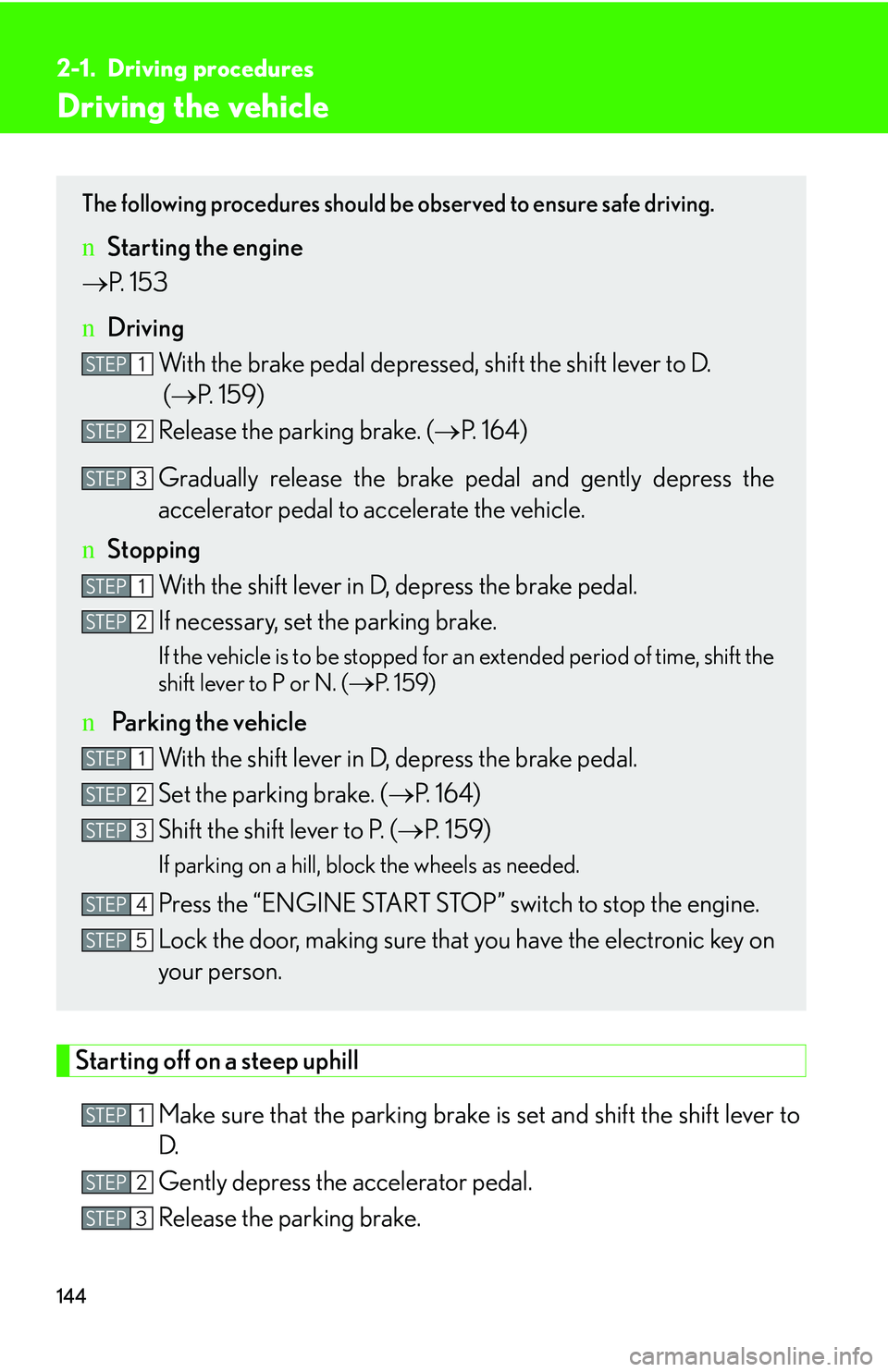
144
2-1. Driving procedures
Driving the vehicle
Starting off on a steep uphill
Make sure that the parking brake is set and shift the shift lever to
D.
Gently depress the accelerator pedal.
Release the parking brake.
The following procedures should be observed to ensure safe driving.
nStarting the engine
�→P. 1 5 3
nDriving
With the brake pedal depressed, shift the shift lever to D.
(�→P. 1 5 9 )
Release the parking brake. (�→P. 164)
Gradually release the brake pedal and gently depress the
accelerator pedal to accelerate the vehicle.
nStopping
With the shift lever in D, depress the brake pedal.
If necessary, set the parking brake.
If the vehicle is to be stopped for an extended period of time, shift the
shift lever to P or N. (�→P. 1 5 9 )
n Parking the vehicle
With the shift lever in D, depress the brake pedal.
Set the parking brake. (�→P. 1 6 4 )
Shift the shift lever to P. (�→P. 1 5 9 )
If parking on a hill, block the wheels as needed.
Press the “ENGINE START STOP” switch to stop the engine.
Lock the door, making sure that you have the electronic key on
your person.
STEP1
STEP2
STEP3
STEP1
STEP2
STEP1
STEP2
STEP3
STEP4
STEP5
STEP1
STEP2
STEP3
Page 217 of 821
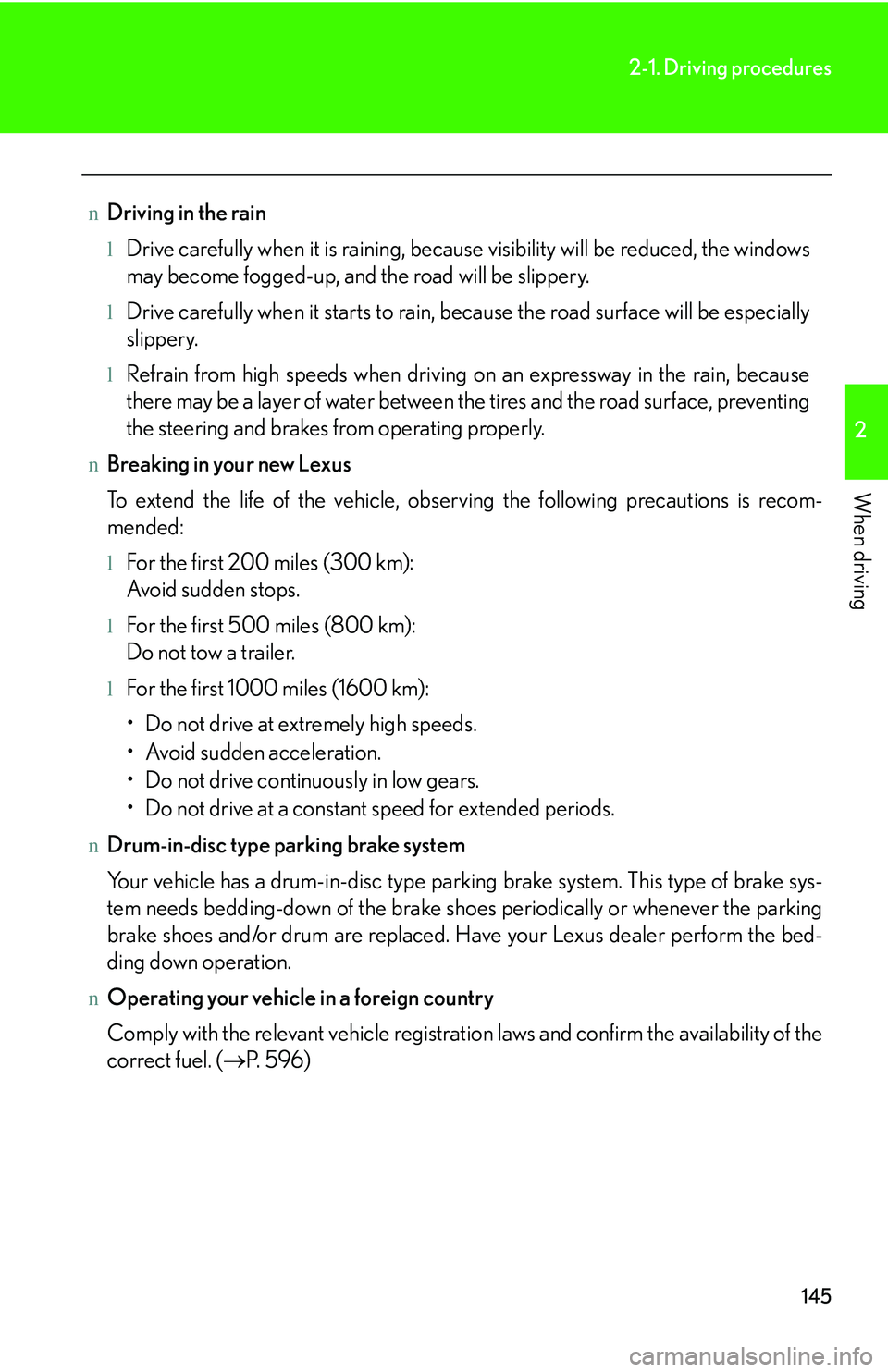
145
2-1. Driving procedures
2
When driving
nDriving in the rain
lDrive carefully when it is raining, because visibility will be reduced, the windows
may become fogged-up, and the road will be slippery.
lDrive carefully when it starts to rain, because the road surface will be especially
slippery.
lRefrain from high speeds when driving on an expressway in the rain, because
there may be a layer of water between the tires and the road surface, preventing
the steering and brakes from operating properly.
nBreaking in your new Lexus
To extend the life of the vehicle, observing the following precautions is recom-
mended:
lFor the first 200 miles (300 km):
Avoid sudden stops.
lFor the first 500 miles (800 km):
Do not tow a trailer.
lFor the first 1000 miles (1600 km):
Page 218 of 821
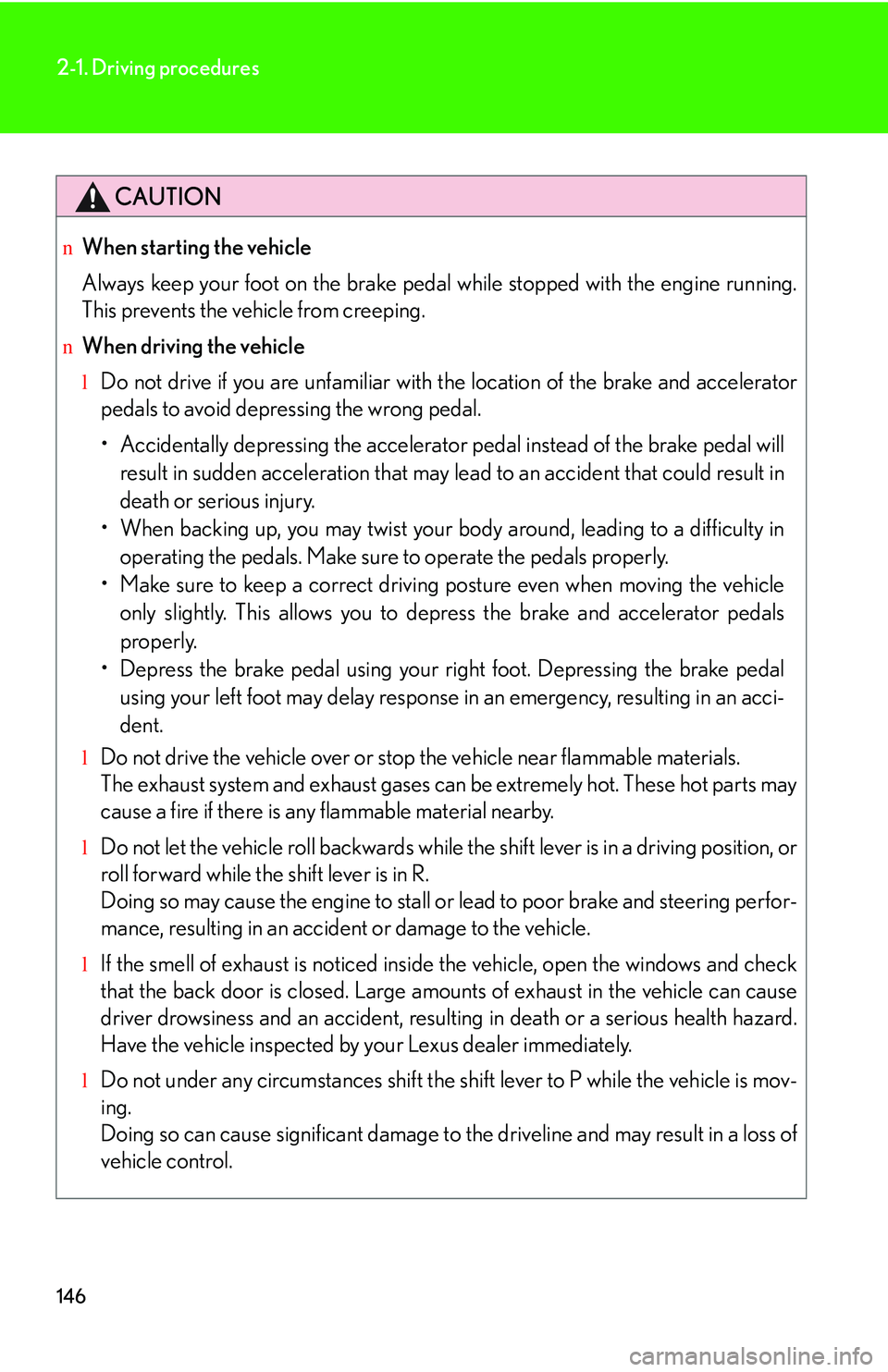
146
2-1. Driving procedures
CAUTION
nWhen starting the vehicle
Always keep your foot on the brake pedal while stopped with the engine running.
This prevents the vehicle from creeping.
nWhen driving the vehicle
lDo not drive if you are unfamiliar with the location of the brake and accelerator
pedals to avoid depressing the wrong pedal.
Page 219 of 821
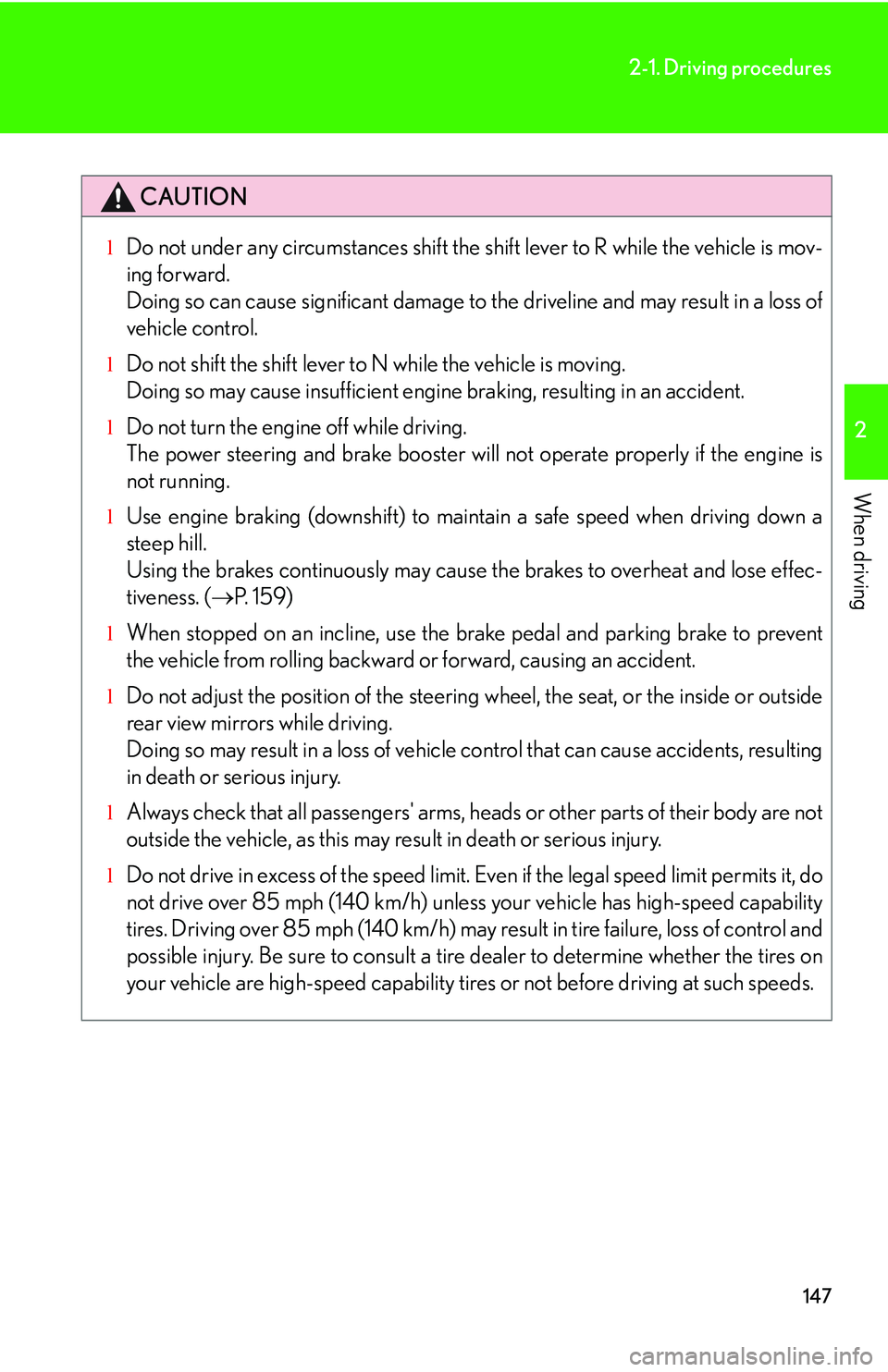
147
2-1. Driving procedures
2
When driving
CAUTION
lDo not under any circumstances shift the shift lever to R while the vehicle is mov-
ing forward.
Doing so can cause significant damage to the driveline and may result in a loss of
vehicle control.
lDo not shift the shift lever to N while the vehicle is moving.
Doing so may cause insufficient engine braking, resulting in an accident.
lDo not turn the engine off while driving.
The power steering and brake booster will not operate properly if the engine is
not running.
lUse engine braking (downshift) to maintain a safe speed when driving down a
steep hill.
Using the brakes continuously may cause the brakes to overheat and lose effec-
tiveness. (�→P. 1 5 9 )
lWhen stopped on an incline, use the brake pedal and parking brake to prevent
the vehicle from rolling backward or forward, causing an accident.
lDo not adjust the position of the steering wheel, the seat, or the inside or outside
rear view mirrors while driving.
Doing so may result in a loss of vehicle control that can cause accidents, resulting
in death or serious injury.
lAlways check that all passengers' arms, heads or other parts of their body are not
outside the vehicle, as this may result in death or serious injury.
lDo not drive in excess of the speed limit. Even if the legal speed limit permits it, do
not drive over 85 mph (140 km/h) unless your vehicle has high-speed capability
tires. Driving over 85 mph (140 km/h) may result in tire failure, loss of control and
possible injury. Be sure to consult a tire dealer to determine whether the tires on
your vehicle are high-speed capability tires or not before driving at such speeds.
Page 220 of 821
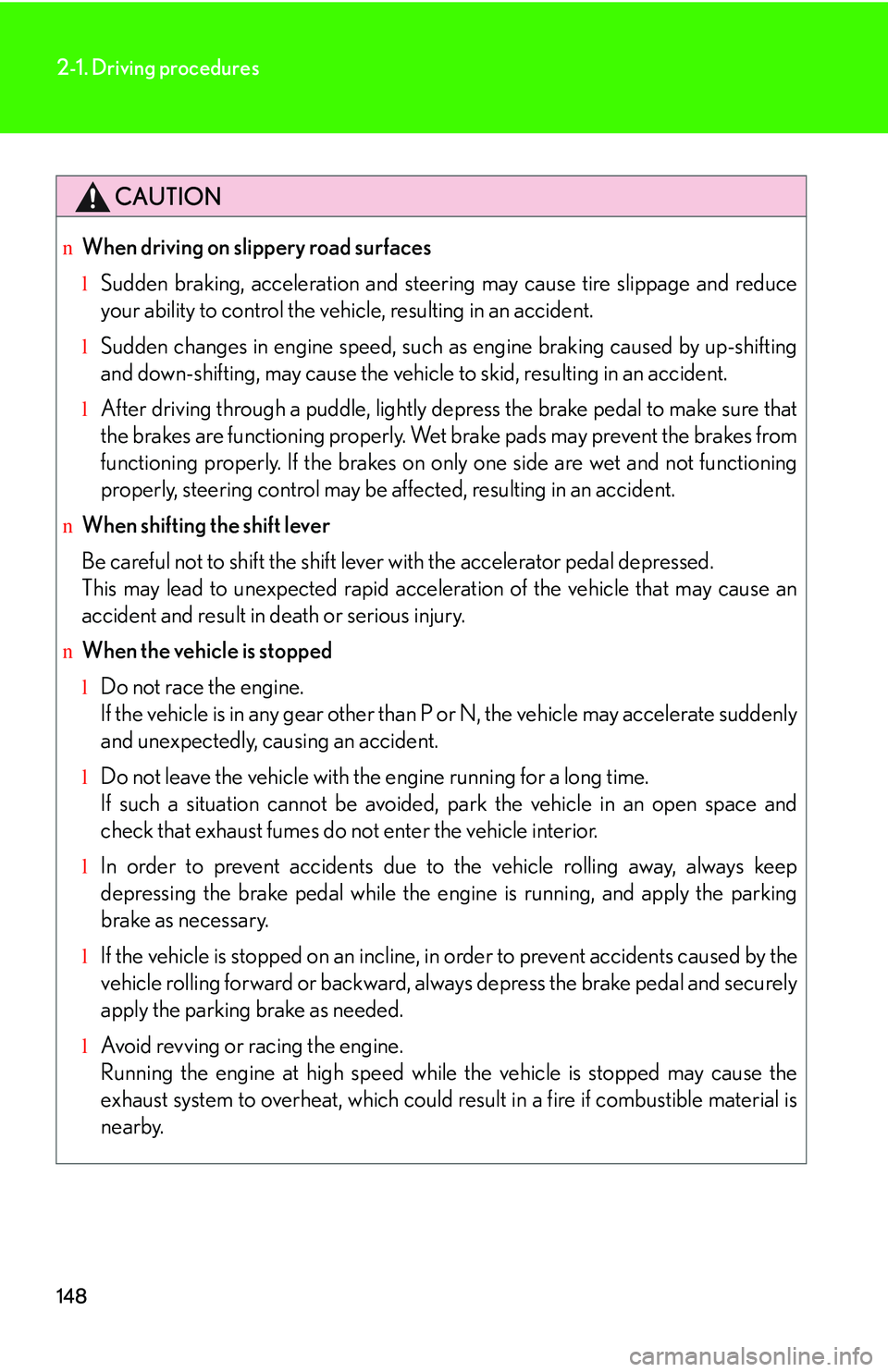
148
2-1. Driving procedures
CAUTION
nWhen driving on slippery road surfaces
lSudden braking, acceleration and steering may cause tire slippage and reduce
your ability to control the vehicle, resulting in an accident.
lSudden changes in engine speed, such as engine braking caused by up-shifting
and down-shifting, may cause the vehicle to skid, resulting in an accident.
lAfter driving through a puddle, lightly depress the brake pedal to make sure that
the brakes are functioning properly. Wet brake pads may prevent the brakes from
functioning properly. If the brakes on only one side are wet and not functioning
properly, steering control may be affected, resulting in an accident.
nWhen shifting the shift lever
Be careful not to shift the shift lever with the accelerator pedal depressed.
This may lead to unexpected rapid acceleration of the vehicle that may cause an
accident and result in death or serious injury.
nWhen the vehicle is stopped
lDo not race the engine.
If the vehicle is in any gear other than P or N, the vehicle may accelerate suddenly
and unexpectedly, causing an accident.
lDo not leave the vehicle with the engine running for a long time.
If such a situation cannot be avoided, park the vehicle in an open space and
check that exhaust fumes do not enter the vehicle interior.
lIn order to prevent accidents due to the vehicle rolling away, always keep
depressing the brake pedal while the engine is running, and apply the parking
brake as necessary.
lIf the vehicle is stopped on an incline, in order to prevent accidents caused by the
vehicle rolling forward or backward, always depress the brake pedal and securely
apply the parking brake as needed.
lAvoid revving or racing the engine.
Running the engine at high speed while the vehicle is stopped may cause the
exhaust system to overheat, which could result in a fire if combustible material is
nearby.